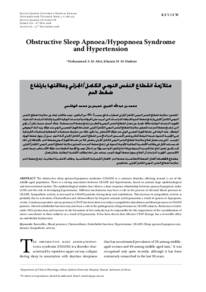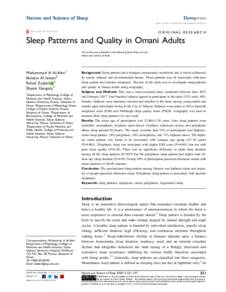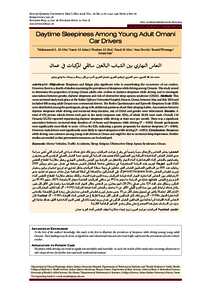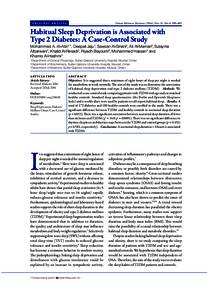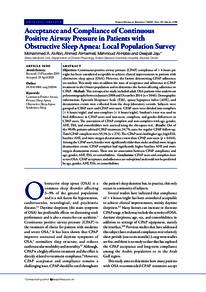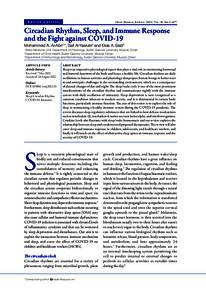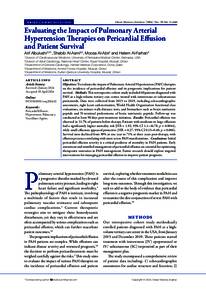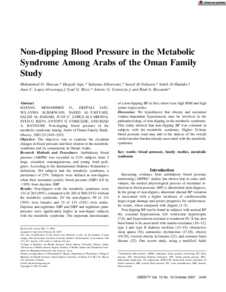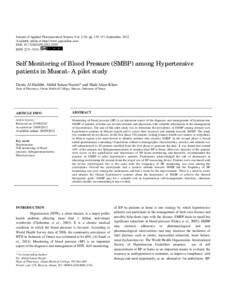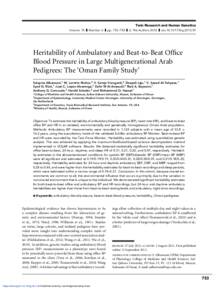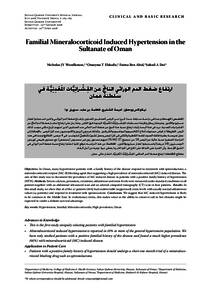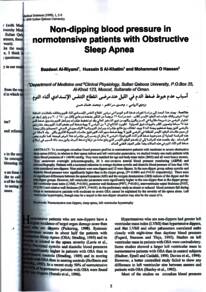Document
Obstructive sleep Apnoea/Hypopnoea syndrome and hypertension.
Contributors
Al-Hashmi, Khamis M., Author
Other titles
متلازمة انقطاع النفس النومي الكامل/ الجزئي وعلاقتها بارتفاع ضغط الدم
Publisher
College of Medicine, Sultan Qaboos University.
Gregorian
2008-11
Language
English
English abstract
The obstructive sleep apnoea/hypopnoea syndrome (OSAHS) is a common disorder, affecting around 2–4% of the middle-aged population. There is a strong association between OSAHS and hypertension, based on animal, large epidemiological and interventional studies. The epidemiological studies have shown a dose-response relationship between apnoea/hypopnoea index (AHI) and the risk of developing hypertension. Different mechanisms may have a role in the process of elevated blood pressure in OSAHS. Sympathetic activity is increased in OSAHS patients during sleep and wakefulness. This increase in sympathetic activity is probably due to activation of baroreflexes and chemoreflexes by frequent arousals and hypoxaemia a result of apnoea or hypopnoea events. Continuous positive airway pressure (CPAP) has been shown to reduce sympathetic stimulation and blood pressure in OSAHS patients. Altered endothelial function may also have a role in the pathogenesis of hypertension in OSAHS subjects. Reduction of nitric oxide (NO) production and increase in the formation of free radicals may be responsible for the impairment of the vasodilatation of micro-vasculature in these subjects as a result of hypoxaemia. It has been shown that effective CPAP therapy has a reversible effect on endothelial dysfunction.
Member of
Resource URL
Arabic abstract
متلازمة انقطاع النفس النومي الكامل/الجزئي اضطراب شائع يصيب 2%-4 من البالغين. توجد علاقة و ثيقة بين متلازمة انقطاع النفس النومي الكامل/الجزئي وارتفاع ضغط الدم وذلك وفقا للدراســات التي اجريت على الحيوانات والدراســات الوبائية الكبيرة وكذلك الدراسات التدخلية. اظهرت الدراسات الوبائية علاقة طردية بين معدل انقطاع النفس النومي والخطر من ارتفاع ضغط الدم مستقبلا. هناك أسباب عديدة يمكن أن تؤدي الــى ارتفــاع ضغط الدم عند المصابين بمتلازمة انقطاع النفس النومي الكامل/الجزئي. فنشــاط الجهاز العصبــي الودي عند هؤلاء يزيد اثناء النوم وفي اليقظة. هذه الزيادة في نشاط الجهاز العصبي الودي عند هؤلاء الأشخاص ربما تكون ناتجة عن تنشيط مستقبلات الضغط والمستقبلات الكيمائية فــي الأوعيــة الدموية نتيجة التيقظ المتكرر ونقص أكســجين الدم الناتج عــن انقطاع النفس الكامل/الجزئي أثناء النوم. تبــين أن جهاز ضغط الهواء الموجــب الذي يســتعمل لعلاج متلازمة انقطاع النفس النومي الكامل/الجزئي يخفض كلا من نشــاط الجهاز الــودي وضغط الدم. بالإضافة إلى ذلك قد يســاعد الخلل في وظائف الأغشــية البطانية للأوعية الدموية في ارتفاع ضغط الدم عند المصابين بمتلازمة انقطاع النفس النومي الكامل/الجزئي. قــد يكــون نقص انتاج غاز اكســيد النيتريك وزيادة انتاج الجذور الحرة مســؤولا عن اختلال توســع الأوعية الدقيقة عند هؤلاء الأشــخاص نتيجة نقص الاكسجين. أظهرت الدراسات أن العلاج بجهاز ضغط الهواء الموجب يساعد على اعادة وظائف الأغشية البطانية بشكل فعال.
Category
Journal articles

